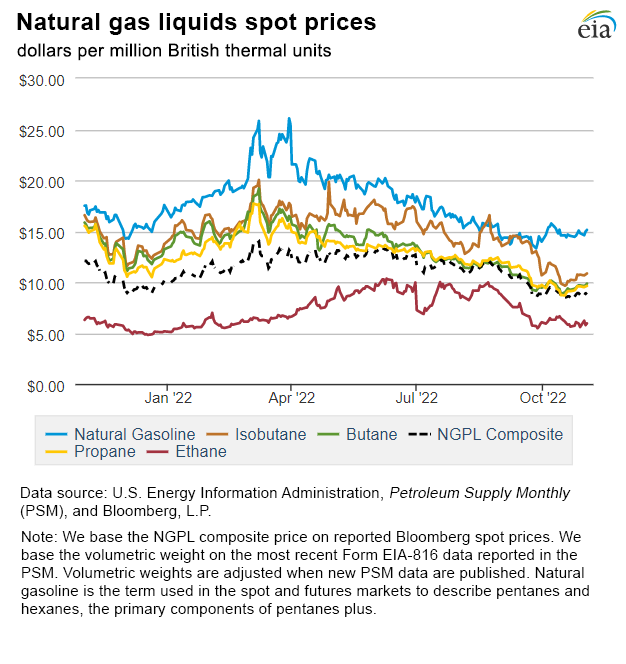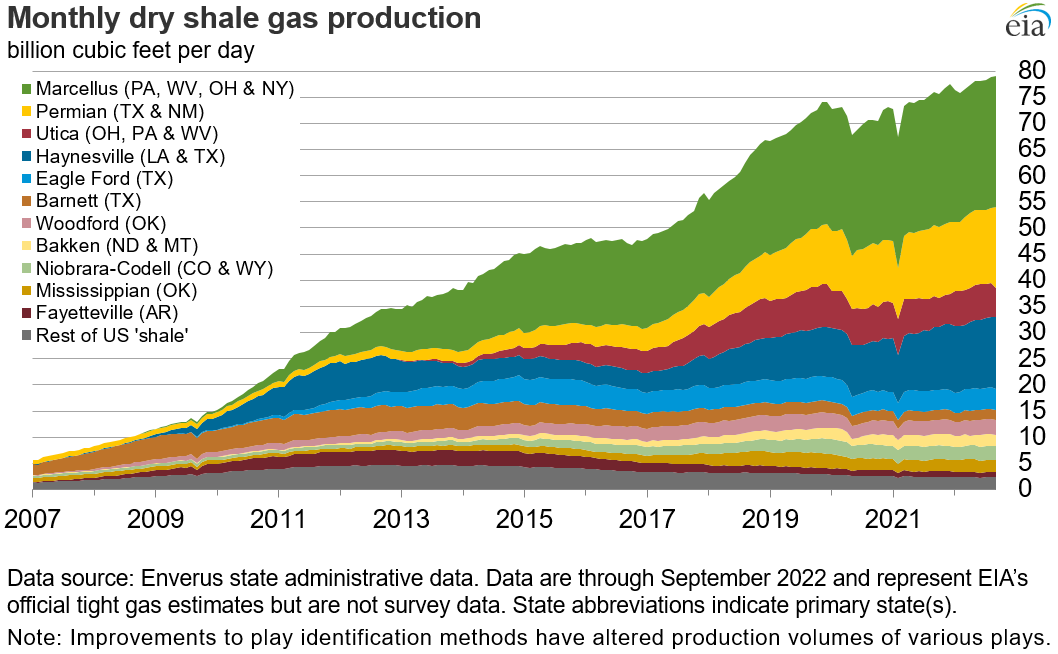In the News:
Natural gas imports from Canada help stabilize U.S. markets
Natural gas imports from Canada, both on a gross and a net basis, have declined since all-time highs reached in the 2000s. Nevertheless, trade with Canada remains an essential element of how the U.S. natural gas market balances and helps to ensure reliable supply in parts of the United States. The ability of Canadian suppliers to rapidly increase flows as a result of ample capacity on pipelines and at storage facilities also helps to stabilize the U.S. market during supply or demand shocks.
In 2005, the share of total U.S. supply of dry natural gas met by pipeline imports from Canada averaged 17%, while U.S. dry natural gas production averaged 49.5 billion cubic feet per day (Bcf/d). Since then, the share of supply made up by imports from Canada has been declining, as U.S. production of natural gas from shale resources has grown. Over the 12-month period through July of this year, gross imports from Canada accounted for on average 8% of U.S. supply, while U.S. production averaged 96.6 Bcf/d.
During this same period, U.S. pipeline exports of natural gas to Canada have increased. In 2000, the share of exports as a percentage of total pipeline natural gas trade with Canada averaged 2%, while in 2005 that share increased to an average of 9%, and over the 12-month period through July of this year it averaged 25%.
Despite the overall reduction in net imports of natural gas from Canada, trade remains important, particularly at the regional level. For example, in the Western region of the United States imports are a source of steady supply and have been trending upwards, averaging 3.6 Bcf/d over the 12-month period through July 2022. Imports that cross the U.S.-Canada border at Sumas, Washington and Eastport, Idaho principally supply metropolitan areas in the Pacific Northwest and California, where several factors have challenged supply and demand balances this year:
- Higher demand for electric power caused by sustained high temperatures and an extreme heat wave this summer
- Lower hydroelectric power generation due to drought
- Reduced natural gas inflows from the Permian Basin due to pipeline constraints
- Reduced inventories at storage facilities operated by Pacific Gas & Electric (PG&E)
Imports from Canada also play an important role in the Eastern region of the United States. In particular, while capacity to supply the Northeast with U.S. natural gas has expanded and the Eastern region is now a net exporter of natural gas to Canada for much of the year, imports from Canada help support annual seasonal fluctuations in consumption, particularly during the annual winter peak, when cold temperatures drive demand for heating. As a result, since 2012, imports into the Eastern region have generally peaked in January or February at approximately 2 Bcf/d and then again in July or August at approximately 1 Bcf/d when high temperatures drive demand for air-conditioning. During the shoulder seasons, net flows of natural gas reverse, flowing into Canada to build inventories.
Canada’s natural gas also helps to cushion against supply and demand shocks. For example, during Winter Storm Uri in February 2021, when U.S. natural gas production fell by a record amount, imports from Canada increased to 9.5 Bcf/d, the highest monthly average since February 2011.
Market Highlights:
(For the week ending Wednesday, November 2, 2022)Prices
- Henry Hub spot price: The Henry Hub spot price fell 75 cents from $5.26 per million British thermal units (MMBtu) last Wednesday to $4.51/MMBtu yesterday.
- Henry Hub futures prices: The November 2022 NYMEX contract expired last Thursday at $5.186/MMBtu, down 42 cents from last Wednesday. The December 2022 NYMEX contract price increased to $6.268/MMBtu, up 15 cents from last Wednesday to yesterday. The price of the 12-month strip averaging December 2022 through November 2023 futures contracts climbed 8 cents to $5.351/MMBtu.
- Select regional spot prices: Natural gas spot prices fell at most locations this report week (Wednesday, October 26, to Wednesday, November 2), but they generally rose out West. Week-over-week price declines at major pricing hubs ranged from $1.55/MMBtu at Chicago Citygate to $0.59/MMBtu at FGT Citygate in Florida, while increases at major pricing hubs ranged from $0.80 at PG&E Citygate in Northern California to $2.72/MMBtu at Waha in West Texas near Permian Basin production activities.
- Prices in the Northeast fell this week, in line with the Henry Hub. At the Algonquin Citygate, which serves Boston-area consumers, the price fell 93 cents from $4.59/MMBtu last Wednesday to $3.66/MMBtu yesterday, and at the Transcontinental Pipeline Zone 6 trading point for New York City, the price decreased $1.25 from $4.44/MMBtu last Wednesday to $3.19/MMBtu yesterday. Temperatures in the Boston Area averaged 54°F this report week, 4°F above normal, leading to 30 fewer heating degree days (HDD) than is normal for this time of year. In the New York-Central Park Area temperatures averaged 57°F, 3°F above normal, leading to 26 fewer HDDs than normal.
- Prices along the Gulf Coast and across the Southeast fell this report week. At the Houston Ship Channel, the price fell $2.25/MMBtu, from $4.55/MMBtu last Wednesday to $2.30/MMBtu yesterday. Total consumption of natural gas across all sectors in Texas fell by 1% (0.1 billion cubic feet per day [Bcf/d]) week over week. In the Houston Area, temperatures remain mild, averaging 65°F this report week, 3°F lower than last report week. Feedgas deliveries to liquefied natural gas (LNG) facilities along the Gulf Coast of South Texas and South Louisiana declined 2% (0.2 Bcf/d) week over week.
- The price at the Waha Hub, which is located near Permian Basin production activities, rose $2.72 this report week, from -$0.65/MMBtu last Wednesday to $2.07/MMBtu yesterday. Having returned from negative pricing last report week, the Waha Hub continued to trade at a significant discount to Henry Hub this report week, as ongoing pipeline maintenance continues to affect westbound flows from the Permian Basin. On Thursday, October 27, Waha traded at a discount of $4.57/MMBtu to Henry Hub, while yesterday the discount was $2.44/MMBtu.
- Prices across the West rose this report week. The price at Opal Hub in southwest Wyoming, the origin point for the Ruby Pipeline that delivers gas to Malin, Oregon, rose $1.05 from $5.52/MMBtu last Wednesday to $6.57/MMBtu yesterday. The price at Malin, Oregon, the northern delivery point into the PG&E service territory, rose $1.62 from $6.39/MMBtu last Wednesday to $8.01/MMBtu yesterday. The price at PG&E Citygate in Northern California rose 80 cents, up from $7.38/MMBtu last Wednesday to $8.18/MMBtu yesterday. In the Sacramento Area, temperatures averaged 57°F, which is 3°F lower than normal. Total consumption of natural gas by all sectors in California increased 4% (0.2 Bcf/d) week over week, according to data from PointLogic.
- In the Pacific Northwest, the price at Sumas on the Canada-Washington border rose $1.77 from $6.01/MMBtu last Wednesday to $7.78/MMBtu yesterday. Total consumption increased by 6% (0.1 Bcf/d) this report week. Temperatures in the Seattle City Area averaged 50°F this report week, resulting in 102 HDDs. Temperatures in the Seattle City Area have fallen significantly in the last two weeks; HDDs totaled 22 just two weeks ago for the report week ending on October 19.
- International futures prices: International natural gas futures prices were mixed this report week. According to Bloomberg Finance, L.P., weekly average futures prices for LNG cargoes in East Asia decreased $2.55 to a weekly average of $28.97/MMBtu, and natural gas futures for delivery at the Title Transfer Facility (TTF) in the Netherlands, the most liquid natural gas market in Europe, increased $2.35 to a weekly average of $33.96/MMBtu.
- Natural gas plant liquids (NGPL) prices: The natural gas plant liquids composite price at Mont Belvieu, Texas, rose by 21 cents/MMBtu, averaging $8.88/MMBtu for the week ending November 2. The weekly average Brent crude oil price also rose by about 3%, causing most NGPL prices to increase. Propane prices rose 3%, normal butane prices rose 3%, isobutane prices rose 4%, and natural gasoline prices rose 2%. Ethane prices, which are generally more closely correlated with natural gas prices, rose by less than 1%, even as weekly average natural gas prices at the Houston Ship Channel declined by 18%, increasing the ethane-to-natural-gas premium by close to 50%. Ethylene prices increased 1%, increasing the ethylene-to-ethane spread by 2%.
Daily spot prices by region are available on the EIA website.
Supply and Demand
- Supply: According to data from PointLogic, the average total supply of natural gas rose by 0.3% (0.3 Bcf/d) compared with the previous report week. Dry natural gas production grew by 0.5% (0.5 Bcf/d), and average net imports from Canada decreased by 4.6% (0.2 Bcf/d) from last week.
- Demand: Total U.S. consumption of natural gas rose by 2.7% (1.8 Bcf/d) compared with the previous report week, according to data from PointLogic. Natural gas consumed for power generation declined by 3.1% (0.9 Bcf/d) week over week. In the residential and commercial sectors, consumption increased by 15.4% (2.5 Bcf/d), and industrial sector consumption increased by 1.0% (0.2 Bcf/d). Natural gas exports to Mexico decreased 1.6% (0.1 Bcf/d). Natural gas deliveries to U.S. LNG export facilities (LNG pipeline receipts) averaged 11.9 Bcf/d, or 0.4 Bcf/d higher than last week.
Liquefied Natural Gas (LNG)
- Pipeline receipts: Overall natural gas deliveries to U.S. LNG export terminals increased by 0.4 Bcf/d week over week to average 11.9 Bcf/d this report week. Natural gas deliveries to Cove Point drove this increase, averaging 0.7 Bcf/d this week as the terminal resumed operations on October 28 following the completion of its annual planned maintenance. Natural gas deliveries to LNG export terminals in South Louisiana decreased by 0.2 Bcf/d to 8.5 Bcf/d, while deliveries to other terminals in the Southeast and South Texas were relatively flat at a combined 2.7 Bcf/d, according to data from PointLogic.
- Vessels departing U.S. ports: Twenty-one LNG vessels (nine from Sabine Pass, four each from Cameron and Corpus Christi, three from Calcasieu Pass, and one from Cove Point) with a combined LNG-carrying capacity of 78 Bcf departed the United States between October 27 and November 2, according to shipping data provided by Bloomberg Finance, L.P.
Rig Count
- According to Baker Hughes, for the week ending Tuesday, October 25, the natural gas rig count decreased by 1 rig from a week ago to 156 rigs. An unidentified producing region added one rig, and the Permian dropped two rigs. The number of oil-directed rigs decreased by 2 rigs from a week ago to 610 rigs. The Cana Woodford and the Permian each added two rigs, and the Arkoma Woodford added one rig. The Eagle Ford, Granite Wash, and Williston each dropped one rig, and four rigs were dropped in unidentified producing regions. The total rig count, which includes 2 miscellaneous rigs, now stands at 768 rigs, which is 224 more rigs than the same week last year.
Storage
- The net injections into storage totaled 107 Bcf for the week ending October 28, compared with the five-year (2017–2021) average net injections of 45 Bcf and last year's net injections of 66 Bcf during the same week. Working natural gas stocks totaled 3,501 Bcf, which is 135 Bcf (4%) lower than the five-year average and 101 Bcf (3%) lower than last year at this time.
- According to The Desk survey of natural gas analysts, estimates of the weekly net change to working natural gas stocks ranged from net injections of 87 Bcf to 109 Bcf, with a median estimate of 100 Bcf.
See also:
Top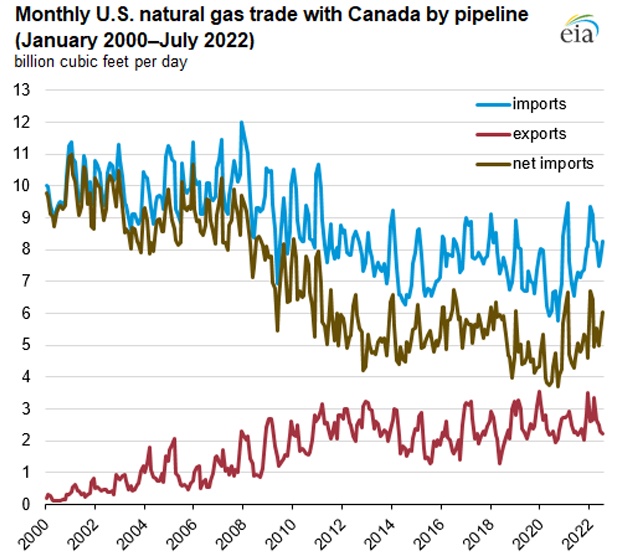
Data source: U.S. Energy Information Administration
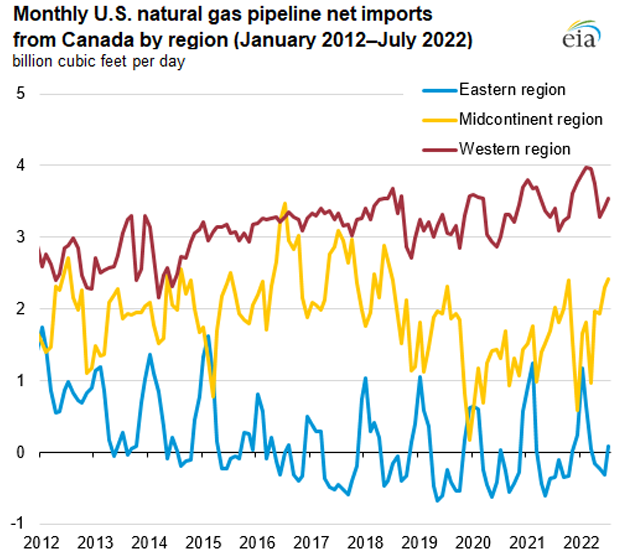
Data source: U.S. Energy Information Administration
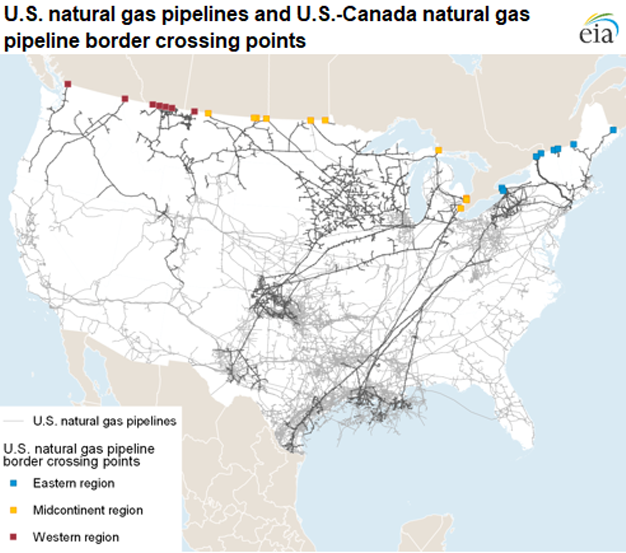
Data source: U.S. Energy Information Administration
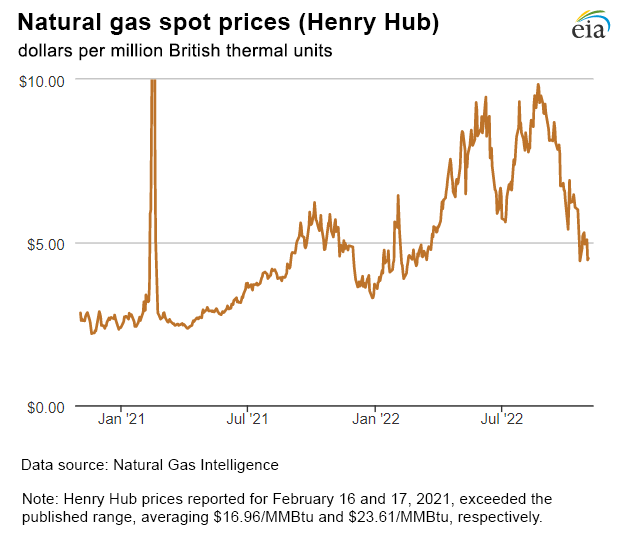
| Spot Prices ($/MMBtu) | Thu, 27-Oct |
Fri, 28-Oct |
Mon, 31-Oct |
Tue, 01-Nov |
Wed, 02-Nov |
|---|---|---|---|---|---|
| Henry Hub |
5.30 |
4.95 |
5.08 |
4.46 |
4.51 |
| New York |
4.47 |
3.33 |
2.98 |
3.12 |
3.19 |
| Chicago |
4.95 |
4.46 |
4.14 |
3.35 |
3.48 |
| Cal. Comp. Avg.* |
6.40 |
5.91 |
6.18 |
7.20 |
7.58 |
| Futures ($/MMBtu) | |||||
| December contract | 5.186 |
5.684 |
6.355 |
5.714 |
6.268 |
| January contract |
5.875 |
5.953 |
6.607 |
6.080 |
6.589 |
| Data source: Natural Gas Intelligence and CME Group as compiled by Bloomberg, L.P. *Avg. of NGI's reported prices for: Malin, PG&E Citygate, and Southern California Border Avg. |
|||||
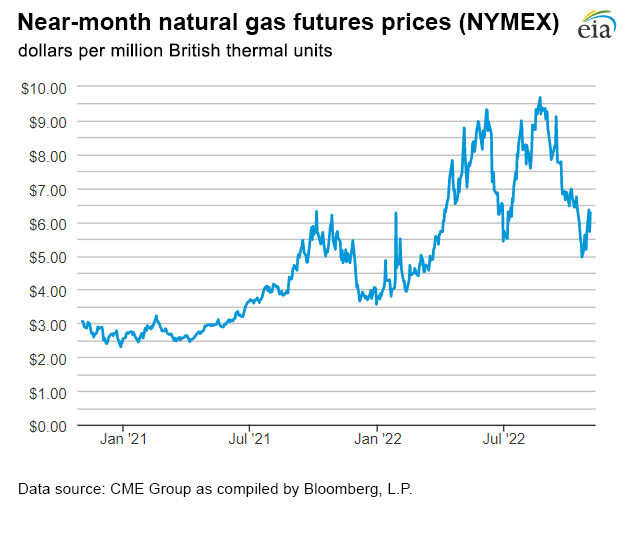
| U.S. natural gas supply - Gas Week: (10/27/22 - 11/2/22) | |||
|---|---|---|---|
Average daily values (billion cubic feet) |
|||
this week |
last week |
last year |
|
| Marketed production | 111.8 |
111.1 |
108.3 |
| Dry production | 99.6 |
99.1 |
97.8 |
| Net Canada imports | 5.0 |
5.2 |
5.5 |
| LNG pipeline deliveries | 0.1 |
0.1 |
0.1 |
| Total supply | 104.7 |
104.4 |
103.3 |
|
Data source: PointLogic | |||
| U.S. natural gas consumption - Gas Week: (10/27/22 - 11/2/22) | |||
|---|---|---|---|
Average daily values (billion cubic feet) |
|||
this week |
last week |
last year |
|
| U.S. consumption | 70.3 |
68.5 |
69.0 |
| Power | 28.4 |
29.3 |
28.1 |
| Industrial | 23.1 |
22.9 |
22.5 |
| Residential/commercial | 18.8 |
16.3 |
18.4 |
| Mexico exports | 5.7 |
5.8 |
6.0 |
| Pipeline fuel use/losses | 6.7 |
6.7 |
6.6 |
| LNG pipeline receipts | 11.9 |
11.5 |
11.0 |
| Total demand | 94.6 |
92.4 |
92.5 |
|
Data source: PointLogic | |||
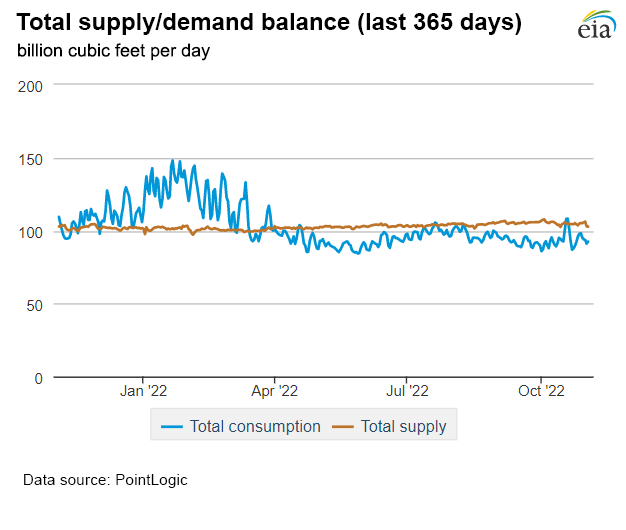
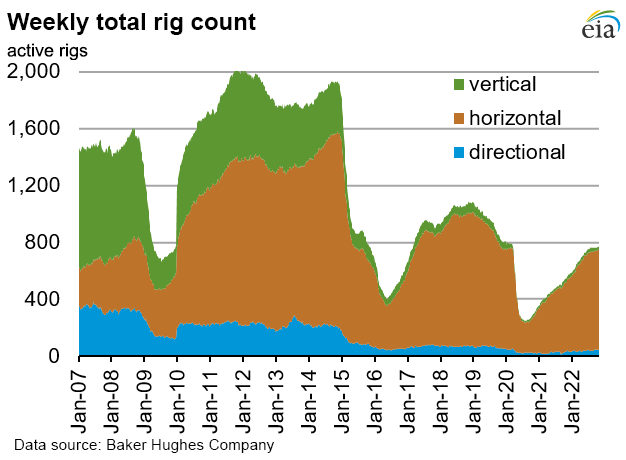
| Rigs | |||
|---|---|---|---|
Tue, October 25, 2022 |
Change from |
||
last week |
last year |
||
| Oil rigs | 610 |
-0.3% |
37.4% |
| Natural gas rigs | 156 |
-0.6% |
56.0% |
| Note: Excludes any miscellaneous rigs | |||
| Rig numbers by type | |||
|---|---|---|---|
Tue, October 25, 2022 |
Change from |
||
last week |
last year |
||
| Vertical | 22 |
0.0% |
-24.1% |
| Horizontal | 703 |
-0.7% |
45.5% |
| Directional | 43 |
4.9% |
34.4% |
| Data source: Baker Hughes Company | |||
| Working gas in underground storage | ||||
|---|---|---|---|---|
Stocks billion cubic feet (Bcf) |
||||
| Region | 2022-10-28 |
2022-10-21 |
change |
|
| East | 848 |
825 |
23 |
|
| Midwest | 1,042 |
1,007 |
35 |
|
| Mountain | 204 |
199 |
5 |
|
| Pacific | 247 |
248 |
-1 |
|
| South Central | 1,160 |
1,116 |
44 |
|
| Total | 3,501 |
3,394 |
107 |
|
| Data source: U.S. Energy Information Administration Form EIA-912, Weekly Underground Natural Gas Storage Report | ||||
| Working gas in underground storage | |||||
|---|---|---|---|---|---|
Historical comparisons |
|||||
Year ago (10/28/21) |
5-year average (2017-2021) |
||||
| Region | Stocks (Bcf) |
% change |
Stocks (Bcf) |
% change |
|
| East | 897 |
-5.5 |
903 |
-6.1 |
|
| Midwest | 1,068 |
-2.4 |
1,072 |
-2.8 |
|
| Mountain | 213 |
-4.2 |
214 |
-4.7 |
|
| Pacific | 256 |
-3.5 |
290 |
-14.8 |
|
| South Central | 1,168 |
-0.7 |
1,156 |
0.3 |
|
| Total | 3,602 |
-2.8 |
3,636 |
-3.7 |
|
| Data source: U.S. Energy Information Administration Form EIA-912, Weekly Underground Natural Gas Storage Report | |||||
| Temperature – heating & cooling degree days (week ending Oct 27) | ||||||||
|---|---|---|---|---|---|---|---|---|
HDDs |
CDDs |
|||||||
| Region | Current total |
Deviation from normal |
Deviation from last year |
Current total |
Deviation from normal |
Deviation from last year |
||
| New England | 73 |
-46 |
-6 |
0 |
0 |
0 |
||
| Middle Atlantic | 68 |
-40 |
4 |
0 |
0 |
0 |
||
| E N Central | 71 |
-46 |
-43 |
1 |
0 |
1 |
||
| W N Central | 87 |
-31 |
-36 |
3 |
2 |
3 |
||
| South Atlantic | 59 |
-4 |
26 |
13 |
-7 |
-14 |
||
| E S Central | 54 |
-9 |
11 |
1 |
-4 |
-5 |
||
| W S Central | 24 |
-6 |
17 |
26 |
6 |
-29 |
||
| Mountain | 126 |
14 |
35 |
3 |
-3 |
-2 |
||
| Pacific | 56 |
9 |
-4 |
1 |
-2 |
1 |
||
| United States | 67 |
-20 |
-6 |
6 |
-1 |
-6 |
||
|
Data source: National Oceanic and Atmospheric Administration Note: HDDs=heating degree days; CDDs=cooling degree days | ||||||||
Average temperature (°F)
7-day mean ending Oct 27, 2022
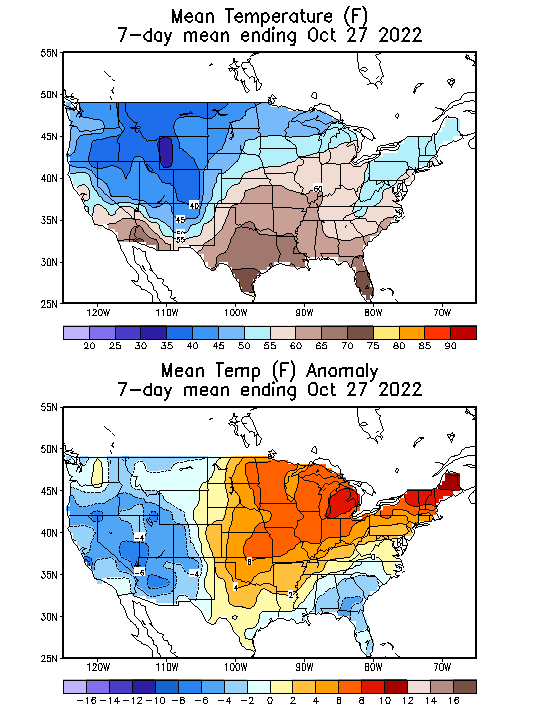
Data source: National Oceanic and Atmospheric Administration
Deviation between average and normal temperature (°F)
7-day mean ending Oct 27, 2022

Data source: National Oceanic and Atmospheric Administration

